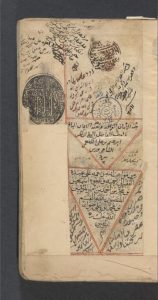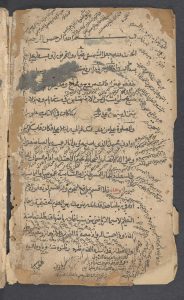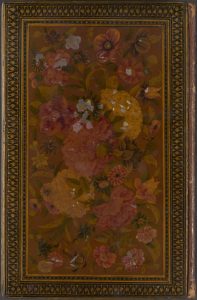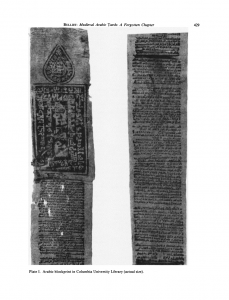

The summer months at Columbia University allow more mental space and time to savor enjoyable conversations and delve into the numerous treasures that the Columbia University Libraries offers to the scholarly community.
Last week, I sat down with Prof. A. Tunç Şen, (who just had a baby) and asked him a few questions about his work with the Islamic manuscripts collection at the Columbia University Libraries. Prof. Tunç Şen is an Assistant Professor in the Department of History, and his research and teaching focus on the early modern Ottoman period and Islamicate worlds, with a particular interest in the history of science and divination, cross-cultural and historical perceptions of time, as well as material and manuscript cultures from the Islamic worlds. Prof. Şen is one of several professors at Columbia who have shown and keenly supported a renewed interest in the Islamic manuscripts collection at RBML, which is the subject of a current CLIR digitization grant. Prof. Tunç Şen taught a course on Islamic manuscript culture at Columbia in the Fall of 2018, and plans to offer it again, as the course was the subject of high interest and excitement on the part of the students.
Q: Tunç, could you please tell us about the course on Islamic manuscript culture, which you offered in the Fall of 2018: how did you conceptualize it, and what was the students’ reception of the readings and the hands-on activities you offered through the course?
The seminar I offered in the Fall of 2018 shared the same title as the ongoing “Manuscripts of the Muslim World” digitization project. When I first conceptualized the course, I was planning to name it: “History of Reading and Writing in the Islamic Manuscript Culture,” as that would have been an accurate representation of the scope I intended to cover. But then, for various pedagogical and publicity purposes (regarding both the project and the seminar) I thought that it may be best to use the same title, just to weave the importance of the Libraries’ Islamic manuscripts collection in particular and the significance of material culture for intellectual inquiry around Islamic cultures and societies in general, onto my teaching. I thought it was a nice way to make people more aware of the tremendous resources we have at hand—the Columbia Univeristy Libraries’ rich manuscript collections, especially when it comes to “hidden” collections such as this one—and to highlight the opportunities they present for creating a unique pedagogical experience for our students. That’s how I decided to go with the project’s title for the course, too: the Manuscripts of the Muslim World Seminar.
Throughout the course, we followed a number of thematic arches, all organized in a discernible chronological sequence. The first thematic arch was the material aspect of the Islamic manuscript culture, ranging from the impact of the so-called paper revolution, to tools and techniques utilized in bookmaking and binding. Then we slowly moved onto our central theme and discussed over a few weeks the different ways we can utilize the para-textual elements of manuscripts for understanding, reconstructing and rewriting the social, cultural, intellectual, and material history of the past. These possibilities are not peculiar to Islamic manuscript traditions, but are shared throughout the history of the book, across periods, cultures, and eras, for any culture or period under study. But of course, unraveling the specific history of a book- making and scribal tradition requires a closer look at the individual items, and engaging with their specific micro-histories. We focused on colophons, ownership statements, or traces of ijāzat al-qirāʾa (reading certificates) or samāʿ (audition certificates) as recorded in the books and their margins.


We looked at blurbs, commentaries and other marginalia recorded in the manuscripts, and we tried to show how these extra-textual materials — books within a book so to speak– can avail us with surprising small details that shed significant light on the personal stories—the micro-story– of these manuscripts as well as their past owners, readers, makers, etc.. What emerges from all of this is a fascinating fresh look at the bigger social, cultural or historical reality at hand, culled out of the traces left in the books of a “lived perspective”, a relation to these items that the readers, owners, writers, producers of those fascinating works had with the manuscripts at hand. Throughout the course, we visited the RBML on a regular fashion and explored some of the items in our collection. Then, toward the end of the semester, we moved on to discuss the formation of libraries (first private/individual, then public, growingly from the seventeenth century onwards), addressed the accumulation of Islamic manuscript collections in the U.S. and elsewhere, and finally revisited the famous (or infamous) debate on the “late” adoption of print technology in the Ottoman/Islamicate context and its implications for our understanding of this period.
What is the added scholarly and pedagogical value of teaching with material culture?
In all the classes I’ve taught so far at Columbia, be it the Core Civilization courses, the History of the Ottoman Empire, or courses on Islamic material culture such as this seminar on the Manuscripts of the Muslim World, I actively integrated periodic visits to RBML into my regular teaching, always pointing out some of these fascinating sources and collections, but also, and most important, raising the students’ awareness of the richness and depth of the learning experience that can be achieved through an open engagement with the manuscripts. This is particularly significant in the current context in which learning and education take place: We are now living in a digital age and it is not entirely uncommon to come across an undergraduate student (likely a digital native) who may have never closely interacted with a physical printed book, let alone a hand written one. The word “manuscript” may sound too esoteric or obsolete to students, as lack of familiarity can unfortunately feed a sense of irrelevance or fear, of being passe or in the best of cases, produce a sense of an inflated awe. All of these expectations can act as hindrances to the act of open learning: yes, every manuscript is “unique” and individual by its very nature but this should not keep us away from taking a more sober and demystified approach in studying manuscripts. We, the scholars, librarians, preservation specialists tend to treat them as precious, luxury items (and there are evident reasons for doing that), but not all manuscripts were originally copied and circulated in the past as such. Especially in the Islamicate context, most manuscripts functioned up until the late nineteenth century as the primary form and medium of pedagogy and scholarship. They were the main, one can even say the quotidian tools of learning way into the late 19th c….
So, to come to your question, one obvious value of using manuscripts in class is to bring these historical artifacts to life again, and feed that pedagogical immediate relation between the object and the learner, imbue the students with that vibrant tradition, that share of the past, which was once experienced and lived by the owners/readers/writers/copyists/sellers of these manuscripts in a quotidian, open, engaged manner.


The lavishly illuminated beautiful copies with fanciful bindings may still dazzle us with their visual/artistic qualities but I think we should also explore more deeply what these individual repositories can reveal to us with their sometimes astonishing personal and mostly quotidian details. It is that sense of discovery of the importance of the lived element in our relation to books and learning, and that deep personal relation to the tools of learning that I seek to bring back alive, and hope to nourish and bring to the learning experience of my current students. I think there is nothing better equipped to achieve this result than exposing students to manuscripts.
Can you please tell us of a learning moment that stood out in the past term, through the usage of manuscripts in your teaching?
I think this is a question better put to my students… But joking aside, I very much enjoyed all the sessions we held at the RBML when we engaged in browsing through select manuscripts from our collection, collectively deciphering the colophons, reading and commenting on the paratexts including the audition certificates and all other types of marginalia. Using cellphones is often not permitted in classes but in my manuscript seminar, cellphones were extremely helpful, because all of us got excited taking photos of some interesting part of a manuscript, and then zooming in to read the text or understand the script more easily, and feeling that Aha moment: “yes, now I get it!!”.

One particular manuscript that I would like to note is Ms Or. 470. Interestingly, a note on the flyleaf of this manuscript reveals an interesting story about a book theft committed in 1799 by a few unnamed French soldiers, and the owners’ lament about the morals of any culture who could steal books (this most probably happened during the French invasion of Egypt). I would like to thank my dear colleague Boris Liebrenz, who had flagged this item for me and directed me to this note. So here, you not only have a very interesting manuscript in its own right, but also have a witness to emotions and feelings and ways of acting around war and books that are recorded in this very personal way… I find it fascinating that this testimony is handed down to us in this form.

 Another interesting piece for me is Or. 360, a late-sixteenth century Ottoman encyclopedia of sciences, that contains numerous minhu records (i.e. glosses added to the margins that can be traced back to the author) presenting interesting details as to different stages/editions the “finished” work might have undergone. Here, too, you have an archive within an archive so to speak, where you get to see a work in evolution. That’s also fascinating…
Another interesting piece for me is Or. 360, a late-sixteenth century Ottoman encyclopedia of sciences, that contains numerous minhu records (i.e. glosses added to the margins that can be traced back to the author) presenting interesting details as to different stages/editions the “finished” work might have undergone. Here, too, you have an archive within an archive so to speak, where you get to see a work in evolution. That’s also fascinating…
The medieval Arabic ṭarsh (print block) now located at p. Col. inv. 705, about which Richard Bulliet had written a short article, is also an interesting piece for complicating the debates on printing technology (or lack thereof) in the Islamicate context. This is a small example of how much can be learned from this collection, and often in surprising ways, once we focus on these microstories embedded between the leaves of each work.
Are there any parts or sub-parts of the collection you plan to research or publish about?Our collection is particularly strong in terms of works devoted to mathematical and astral sciences thanks in particular to the scholarly and collecting interests of David Eugene Smith, a professor of mathematics at Teacher’s College in the first quarter of the twentieth century. In my own work, I examine the astral lore produced in the fifteenth and sixteenth century Ottoman/Persianate context. I hope I will have more time in the near future to explore more closely the zījes (astronomical tables) and other astronomical/astrological treatises collected by David E. Smith during his travels to the Muslim World.

Can you please comment on the conception of the MWM project as driven by students’ curiosity and learning interests?
One of the greatest things about the MWM project is the fact that it has been initiated and conceptualized by our own graduate students. I think we should keep that spirit alive in the next stages of the project. My seminar was also partially intended to “recruit” new students to the project. As part of the course requirements, I asked my students to pick a particular item (or a set of items) from our collection and write their final papers to describe and contextualize the content and the scholarly significance of the select manuscript. I very much enjoyed and learned a lot from the final papers my students submitted. Two of my students, Trevor Brabyn and Shabbir Agha Abbas, eventually started working in the ongoing cataloging/digitization project. I strongly believe that this number will increase as more students will get interested in exploring the hidden gems of our collections and of the manuscript universe!
In closing, can you please comment on how you see this project fitting in within the politics of knowledge representation across the bigger scholarly eco-system?

Codicology, Manuscript studies, or the History of Reading in the Western/European context are much more established and institutionalized disciplines and scholarly traditions. The scholarship about Islamic manuscript culture has witnessed a promising renewed interest in the last decade or so, thanks not only to a number of digitization projects undertaken by different university and other research libraries but also to the publication of a series of outstanding catalogs and monographs, as well as a number of specialized journals, including the Journal of Islamic Manuscripts; Manuscripts of the Middle East , among others.
I believe that it is our task to create a closer dialogue between the scholars and the students across different traditions. We were particularly fortunate for example, in the Fall 2018 to be able to encourage such interdisciplinary exchange and dialogue, as during that term, there were several courses offered on campus around Book History, Medieval Manuscripts, and Print Cultures. Joining efforts with other instructors, we managed to organize a “Book Fair” at RBML at the end of the semester. There, students put on display and briefly discussed some manuscript items from the RBML collections that they were working on. These mini-presentations, from a variety of perspectives, cultures, histories and backgrounds, including Arabic, Jewish, Latin, Persian etc. were extremely interesting and engaging, and opened up possibilities for dialogue and scholarly exchanges. We had side by side a Latin Book of Hours for example, next to a Persian astronomical treatise: you can imagine the wonderful conversations this could spark! A project like the Manuscripts of the Muslim World, and events such as the Book Fair, will certainly help deepen scholarship, support diversity in research over various “hidden” or under-represented perspectives, and explore scholarly possibilities across eras, languages, traditions, cultures and histories. It’s so enriching, and eye opening– for all!!
For inquiries regarding the Muslim World Manuscript project at Columbia, please contact RBML: Jane Siegel: Librarian for Rare Books & Bibliographic Services: jane.siegel@columbia.edu; Peter Magierski:The Middle East and Islamic Studies Librarian: pm2650@columbia.edu, or Kaoukab Chebaro: Global Studies, Head: kc3287@ columbia.edu
Kaoukab Chebaro, Global Studies, Head, Columbia University Libraries
2 thoughts on “The Muslim World Manuscript Project: A great Pedagogical tool! What can manuscripts teach us?”